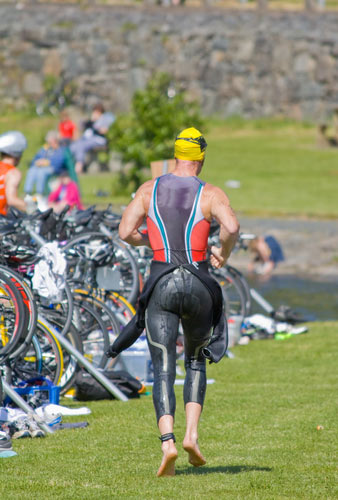Posted by A.J. Nygren on 20th Jul 2017
Triathlon Transition Tips
Triathlon is a unique sport. How many other events do you know of that make the participants change equipment as part of the race? These “transitions” as they are called provide an opportunity to gain precious seconds if you have a plan in place and are prepared with the right gear. In triathlon, there are two transitions. The first of which is known as “T1” and T1 takes place when the participants exit the swim portion of the race and make their way to the cycling portion. So, how does one transition from swimming to cycling quickly and efficiently?
Let’s begin with equipment. We will assume we are in a wetsuit legal race and you will need to strip off a full-size wetsuit, swim cap, and goggles. In many races, there will be hoses or misting systems that are meant to aid the participants in removing their wetsuits by using the water to lubricate the skin. There are also products like BodyGlide that can be applied before suiting up and these will help with putting on and taking off the wetsuit. Begin by unzipping your wetsuit in the back and removing it from your upper body and arms; you can do this as soon as you’re out of the water. It is recommended that you have a tri-suit or other suitable clothing under your wetsuit to save loads of time by not having to change clothes. This is not mandatory; you can certainly have a set of clothes at your transition station. Then you can remove your goggles and cap. It is important to note that each triathlon course is set up differently and you will have to study the areas of T1 and T2 so you can make sure that you know your way in, out, and around. Nothing costs time like being lost in a crowded transition zone.

When you reach your bike, take the rest of the wetsuit off and let the legs turn inside out. Now you are ready to get your cycling gear together. You will need your helmet, cycling shoes, race belt, and possibly sunglasses. Triathletes recommend keeping your equipment to a minimum and skipping time consuming steps like socks. Many triathlon cycling shoes are designed to be worn barefoot which make socks unnecessary (for now). Some triathletes like to keep their cycling shoes in the pedals even before they begin riding. This is up to personal preference because it allows you to get on your bike faster but your acceleration is slowed until you can secure the shoes on your feet. If you choose to put your shoes on first, you have the ability to accelerate more quickly out of the gate. Remember to put your helmet on first thing and run with your bike to the transition exit! One should also keep some items like water bottles, air for any flat tires, and perhaps some energy gels or chews attached to one’s bike to save time packing gear. Now we will move on to the second transition.
Transition 2 or “T2” is the transition from the cycling course to the running course. This transition involves leaving your cycling kit and changing into your running shoes. Other than shoes, you may need a hydration belt, running hat/visor, and more nutrition. You can save some time by dismounting the bicycle barefoot and running to your transition station; make sure to leave your helmet on until you have entered the transition zone. Once you’re there, you’ll remove your helmet and switch shoes. Some people prefer running shoes that can be worn barefoot and some are willing to take the time in transition for extra comfort and blister prevention. There are others that will sprinkle their running shoes with baby powder or use lace locks/speed laces to make them easier to slip on. When you have your running shoes on, grab your hat/visor, hydration belt, and keep moving! Putting gear on while moving is a great transition time saver. When preparing for your triathlon, be sure to practice your transitions in addition to the rest of your training. You can get a lot of time saved for just a little extra effort and repetition by learning the flow of T1 and T2 in your free time.

